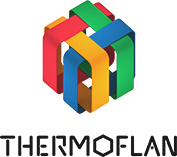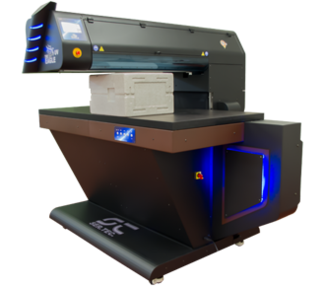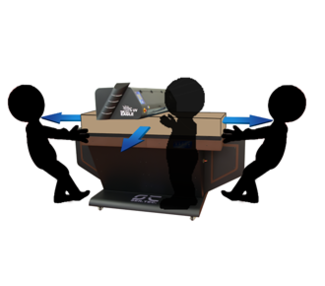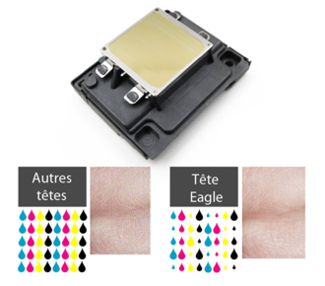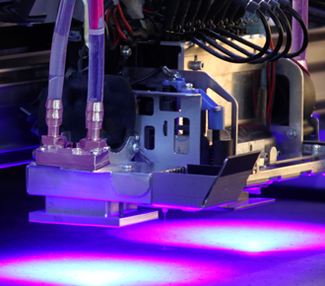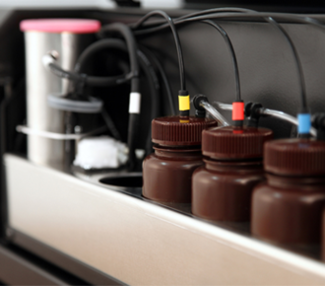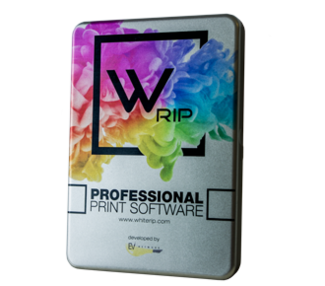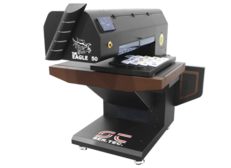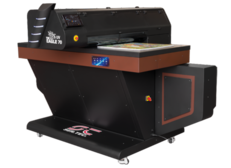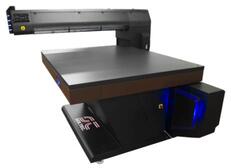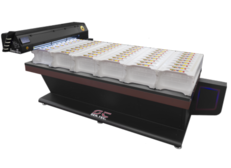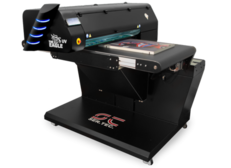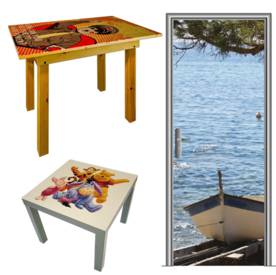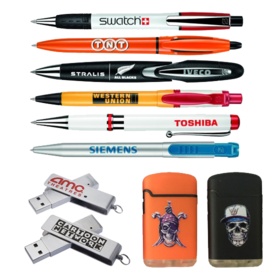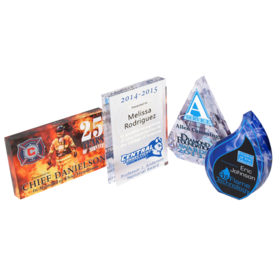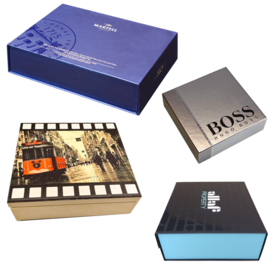Directly print on almost any media
with EAGLE UV range
Videos
Faq
Several techniques can be used for printing objects : pad printing, screen printing, sublimation, offset, ... UV digital printing is one that has many technical advantages and few drawbacks.
Pad printing, screen printing, offset require intermediatel processing steps (production of film, screen, cliché, plate ...) resulting in additional handling and costs that do no exist in UV printing.
Pad printing, screen printing, offset are meant for serial production, not for single part or small series due to the significant cost of screen, cliche... that amortizes on the number of parts. With UV digital printing, no intermediate step is necessary. Printing is direct.
Pad printing, screen printing, ... mainly use inks with solvents that need some time to evaporate. Printed parts cannot be used immediatly. In UV printing, ink is immediately polymerized by a UV LED lamp. Printed products can be used without delay.
Our range of industrial printers is wide :
- Standard machines are Eagle 50...... 700 x 500 mm, height 250 mm
Eagle 70...... 700 x 1500 mm, height 250 mm
Eagle130..... 1300 x 1500 mm, height 250 mm
- Machine range comes complete with XL version with 700 or 1300 widths and 2500 to 5000 mm lengths by 500 mm steps.
- Standard height of 250 mm can be adjusted according to particular applications (for instance 1150 mm in one of our projects)
- All machines can be optionally supplied with a rotary device allowing to print around cylindrical objects (bottles, cans of paint, ...)
UV printing has some limitations:
- It is not possible to print on too convex or concave or irregular surfaces. Print head moving 2 mm above part surface, nothing should obstruct its movement. In case printing part is not perfectly flat, marking accuracy may be impaired when distance between head and printed surface exceeds 4-5 mm
Note: it is however possible to print golf or ping pong balls or pen bodies, reducing their marking surface (example 21-22 mm for golf ball) .
In addition, machines can be equipped with a rotation tool making printing possible on perfect cylinders: wine bottles, gourds, fire extinguishers
- some materials require the application of primer over their surface before printing, so that ink can adhere to the support.
Two kinds of option are available but some must be chosen when ordering (cannot be added later):
- when ordering:
vacuum table (to maintain flexible materials during printing),
positioning tabs (retractable studs for easy positioning of panels or templates),
selective varnish (gloss in parts of printing area)
- later :
rotary tool (to print around cylindrical objects)
With a UV printer, it is possible to print a multitude of supports: lexan, glass, wood, pmma, aluminum, stainless steel, ... however some of them require a special pre-treatment consisting in applying with a cotton pad, brush, airbrush... a "bonding" primer to make ink adhere on material during UV printing.
We have several primers for different applications.
Since inks do not break when bent, they can be applied both on rigid and flexible items.
UV printing is fast and direct :
- Product to be printed is positioned on the printing table. For increased productivity, it is possible to make jig / template with places where parts are inserted
- Graphic file with pattern is designed in appropriate CAD software (photoshop, illustrator, coreldraw, ...) and exported in the Rip (Raster Image Processor) special software , replacing driver for print control : faster printing, improved colors, management of printing modes ...
- Pattern is adjusted in terms of size, positioning and printing mode (resolution, drop size ...)
- File is sent for printing : machine is automatically adjusted according to product thickness and printing is carried out.
- Printed product is immediately available and can be unloaded, while the machine goes back
Printing speed depends on expected print quality, marking sizes and empty spaces (blank areas are "skipped" by the machine), ink drop size and lamp management mode.
Only tests allow to validate actual output according to desired results. We are at your disposal to carry out tests in our show room.
Printing cost : the machine can be equipped with an optional cost calculator. Before printing, rip software calculates necessary ink amount and quotes marking cost.
Several techniques can be used for printing objects : pad printing, screen printing, sublimation, offset, ... UV digital printing is one that has many technical advantages and few drawbacks.
Pad printing, screen printing, offset require intermediatel processing steps (production of film, screen, cliché, plate ...) resulting in additional handling and costs that do no exist in UV printing.
Pad printing, screen printing, offset are meant for serial production, not for single part or small series due to the significant cost of screen, cliche... that amortizes on the number of parts. With UV digital printing, no intermediate step is necessary. Printing is direct.
Pad printing, screen printing, ... mainly use inks with solvents that need some time to evaporate. Printed parts cannot be used immediatly. In UV printing, ink is immediately polymerized by a UV LED lamp. Printed products can be used without delay.
Our range of industrial printers is wide :
- Standard machines are Eagle 50...... 700 x 500 mm, height 250 mm
Eagle 70...... 700 x 1500 mm, height 250 mm
Eagle130..... 1300 x 1500 mm, height 250 mm
- Machine range comes complete with XL version with 700 or 1300 widths and 2500 to 5000 mm lengths by 500 mm steps.
- Standard height of 250 mm can be adjusted according to particular applications (for instance 1150 mm in one of our projects)
- All machines can be optionally supplied with a rotary device allowing to print around cylindrical objects (bottles, cans of paint, ...)
UV printing has some limitations:
- It is not possible to print on too convex or concave or irregular surfaces. Print head moving 2 mm above part surface, nothing should obstruct its movement. In case printing part is not perfectly flat, marking accuracy may be impaired when distance between head and printed surface exceeds 4-5 mm
Note: it is however possible to print golf or ping pong balls or pen bodies, reducing their marking surface (example 21-22 mm for golf ball) .
In addition, machines can be equipped with a rotation tool making printing possible on perfect cylinders: wine bottles, gourds, fire extinguishers
- some materials require the application of primer over their surface before printing, so that ink can adhere to the support.
Two kinds of option are available but some must be chosen when ordering (cannot be added later):
- when ordering:
vacuum table (to maintain flexible materials during printing),
positioning tabs (retractable studs for easy positioning of panels or templates),
selective varnish (gloss in parts of printing area)
- later :
rotary tool (to print around cylindrical objects)
With a UV printer, it is possible to print a multitude of supports: lexan, glass, wood, pmma, aluminum, stainless steel, ... however some of them require a special pre-treatment consisting in applying with a cotton pad, brush, airbrush... a "bonding" primer to make ink adhere on material during UV printing.
We have several primers for different applications.
Since inks do not break when bent, they can be applied both on rigid and flexible items.
UV printing is fast and direct :
- Product to be printed is positioned on the printing table. For increased productivity, it is possible to make jig / template with places where parts are inserted
- Graphic file with pattern is designed in appropriate CAD software (photoshop, illustrator, coreldraw, ...) and exported in the Rip (Raster Image Processor) special software , replacing driver for print control : faster printing, improved colors, management of printing modes ...
- Pattern is adjusted in terms of size, positioning and printing mode (resolution, drop size ...)
- File is sent for printing : machine is automatically adjusted according to product thickness and printing is carried out.
- Printed product is immediately available and can be unloaded, while the machine goes back
Printing speed depends on expected print quality, marking sizes and empty spaces (blank areas are "skipped" by the machine), ink drop size and lamp management mode.
Only tests allow to validate actual output according to desired results. We are at your disposal to carry out tests in our show room.
Printing cost : the machine can be equipped with an optional cost calculator. Before printing, rip software calculates necessary ink amount and quotes marking cost.
Several techniques can be used for printing objects : pad printing, screen printing, sublimation, offset, ... UV digital printing is one that has many technical advantages and few drawbacks.
Pad printing, screen printing, offset require intermediatel processing steps (production of film, screen, cliché, plate ...) resulting in additional handling and costs that do no exist in UV printing.
Pad printing, screen printing, offset are meant for serial production, not for single part or small series due to the significant cost of screen, cliche... that amortizes on the number of parts. With UV digital printing, no intermediate step is necessary. Printing is direct.
Pad printing, screen printing, ... mainly use inks with solvents that need some time to evaporate. Printed parts cannot be used immediatly. In UV printing, ink is immediately polymerized by a UV LED lamp. Printed products can be used without delay.
Our range of industrial printers is wide :
- Standard machines are Eagle 50...... 700 x 500 mm, height 250 mm
Eagle 70...... 700 x 1500 mm, height 250 mm
Eagle130..... 1300 x 1500 mm, height 250 mm
- Machine range comes complete with XL version with 700 or 1300 widths and 2500 to 5000 mm lengths by 500 mm steps.
- Standard height of 250 mm can be adjusted according to particular applications (for instance 1150 mm in one of our projects)
- All machines can be optionally supplied with a rotary device allowing to print around cylindrical objects (bottles, cans of paint, ...)
UV printing has some limitations:
- It is not possible to print on too convex or concave or irregular surfaces. Print head moving 2 mm above part surface, nothing should obstruct its movement. In case printing part is not perfectly flat, marking accuracy may be impaired when distance between head and printed surface exceeds 4-5 mm
Note: it is however possible to print golf or ping pong balls or pen bodies, reducing their marking surface (example 21-22 mm for golf ball) .
In addition, machines can be equipped with a rotation tool making printing possible on perfect cylinders: wine bottles, gourds, fire extinguishers
- some materials require the application of primer over their surface before printing, so that ink can adhere to the support.
Two kinds of option are available but some must be chosen when ordering (cannot be added later):
- when ordering:
vacuum table (to maintain flexible materials during printing),
positioning tabs (retractable studs for easy positioning of panels or templates),
selective varnish (gloss in parts of printing area)
- later :
rotary tool (to print around cylindrical objects)
With a UV printer, it is possible to print a multitude of supports: lexan, glass, wood, pmma, aluminum, stainless steel, ... however some of them require a special pre-treatment consisting in applying with a cotton pad, brush, airbrush... a "bonding" primer to make ink adhere on material during UV printing.
We have several primers for different applications.
Since inks do not break when bent, they can be applied both on rigid and flexible items.
UV printing is fast and direct :
- Product to be printed is positioned on the printing table. For increased productivity, it is possible to make jig / template with places where parts are inserted
- Graphic file with pattern is designed in appropriate CAD software (photoshop, illustrator, coreldraw, ...) and exported in the Rip (Raster Image Processor) special software , replacing driver for print control : faster printing, improved colors, management of printing modes ...
- Pattern is adjusted in terms of size, positioning and printing mode (resolution, drop size ...)
- File is sent for printing : machine is automatically adjusted according to product thickness and printing is carried out.
- Printed product is immediately available and can be unloaded, while the machine goes back
Printing speed depends on expected print quality, marking sizes and empty spaces (blank areas are "skipped" by the machine), ink drop size and lamp management mode.
Only tests allow to validate actual output according to desired results. We are at your disposal to carry out tests in our show room.
Printing cost : the machine can be equipped with an optional cost calculator. Before printing, rip software calculates necessary ink amount and quotes marking cost.
Several techniques can be used for printing objects : pad printing, screen printing, sublimation, offset, ... UV digital printing is one that has many technical advantages and few drawbacks.
Pad printing, screen printing, offset require intermediatel processing steps (production of film, screen, cliché, plate ...) resulting in additional handling and costs that do no exist in UV printing.
Pad printing, screen printing, offset are meant for serial production, not for single part or small series due to the significant cost of screen, cliche... that amortizes on the number of parts. With UV digital printing, no intermediate step is necessary. Printing is direct.
Pad printing, screen printing, ... mainly use inks with solvents that need some time to evaporate. Printed parts cannot be used immediatly. In UV printing, ink is immediately polymerized by a UV LED lamp. Printed products can be used without delay.
Our range of industrial printers is wide :
- Standard machines are Eagle 50...... 700 x 500 mm, height 250 mm
Eagle 70...... 700 x 1500 mm, height 250 mm
Eagle130..... 1300 x 1500 mm, height 250 mm
- Machine range comes complete with XL version with 700 or 1300 widths and 2500 to 5000 mm lengths by 500 mm steps.
- Standard height of 250 mm can be adjusted according to particular applications (for instance 1150 mm in one of our projects)
- All machines can be optionally supplied with a rotary device allowing to print around cylindrical objects (bottles, cans of paint, ...)
UV printing has some limitations:
- It is not possible to print on too convex or concave or irregular surfaces. Print head moving 2 mm above part surface, nothing should obstruct its movement. In case printing part is not perfectly flat, marking accuracy may be impaired when distance between head and printed surface exceeds 4-5 mm
Note: it is however possible to print golf or ping pong balls or pen bodies, reducing their marking surface (example 21-22 mm for golf ball) .
In addition, machines can be equipped with a rotation tool making printing possible on perfect cylinders: wine bottles, gourds, fire extinguishers
- some materials require the application of primer over their surface before printing, so that ink can adhere to the support.
Two kinds of option are available but some must be chosen when ordering (cannot be added later):
- when ordering:
vacuum table (to maintain flexible materials during printing),
positioning tabs (retractable studs for easy positioning of panels or templates),
selective varnish (gloss in parts of printing area)
- later :
rotary tool (to print around cylindrical objects)
With a UV printer, it is possible to print a multitude of supports: lexan, glass, wood, pmma, aluminum, stainless steel, ... however some of them require a special pre-treatment consisting in applying with a cotton pad, brush, airbrush... a "bonding" primer to make ink adhere on material during UV printing.
We have several primers for different applications.
Since inks do not break when bent, they can be applied both on rigid and flexible items.
UV printing is fast and direct :
- Product to be printed is positioned on the printing table. For increased productivity, it is possible to make jig / template with places where parts are inserted
- Graphic file with pattern is designed in appropriate CAD software (photoshop, illustrator, coreldraw, ...) and exported in the Rip (Raster Image Processor) special software , replacing driver for print control : faster printing, improved colors, management of printing modes ...
- Pattern is adjusted in terms of size, positioning and printing mode (resolution, drop size ...)
- File is sent for printing : machine is automatically adjusted according to product thickness and printing is carried out.
- Printed product is immediately available and can be unloaded, while the machine goes back
Printing speed depends on expected print quality, marking sizes and empty spaces (blank areas are "skipped" by the machine), ink drop size and lamp management mode.
Only tests allow to validate actual output according to desired results. We are at your disposal to carry out tests in our show room.
Printing cost : the machine can be equipped with an optional cost calculator. Before printing, rip software calculates necessary ink amount and quotes marking cost.
Several techniques can be used for printing objects : pad printing, screen printing, sublimation, offset, ... UV digital printing is one that has many technical advantages and few drawbacks.
Pad printing, screen printing, offset require intermediatel processing steps (production of film, screen, cliché, plate ...) resulting in additional handling and costs that do no exist in UV printing.
Pad printing, screen printing, offset are meant for serial production, not for single part or small series due to the significant cost of screen, cliche... that amortizes on the number of parts. With UV digital printing, no intermediate step is necessary. Printing is direct.
Pad printing, screen printing, ... mainly use inks with solvents that need some time to evaporate. Printed parts cannot be used immediatly. In UV printing, ink is immediately polymerized by a UV LED lamp. Printed products can be used without delay.
Our range of industrial printers is wide :
- Standard machines are Eagle 50...... 700 x 500 mm, height 250 mm
Eagle 70...... 700 x 1500 mm, height 250 mm
Eagle130..... 1300 x 1500 mm, height 250 mm
- Machine range comes complete with XL version with 700 or 1300 widths and 2500 to 5000 mm lengths by 500 mm steps.
- Standard height of 250 mm can be adjusted according to particular applications (for instance 1150 mm in one of our projects)
- All machines can be optionally supplied with a rotary device allowing to print around cylindrical objects (bottles, cans of paint, ...)
UV printing has some limitations:
- It is not possible to print on too convex or concave or irregular surfaces. Print head moving 2 mm above part surface, nothing should obstruct its movement. In case printing part is not perfectly flat, marking accuracy may be impaired when distance between head and printed surface exceeds 4-5 mm
Note: it is however possible to print golf or ping pong balls or pen bodies, reducing their marking surface (example 21-22 mm for golf ball) .
In addition, machines can be equipped with a rotation tool making printing possible on perfect cylinders: wine bottles, gourds, fire extinguishers
- some materials require the application of primer over their surface before printing, so that ink can adhere to the support.
Two kinds of option are available but some must be chosen when ordering (cannot be added later):
- when ordering:
vacuum table (to maintain flexible materials during printing),
positioning tabs (retractable studs for easy positioning of panels or templates),
selective varnish (gloss in parts of printing area)
- later :
rotary tool (to print around cylindrical objects)
With a UV printer, it is possible to print a multitude of supports: lexan, glass, wood, pmma, aluminum, stainless steel, ... however some of them require a special pre-treatment consisting in applying with a cotton pad, brush, airbrush... a "bonding" primer to make ink adhere on material during UV printing.
We have several primers for different applications.
Since inks do not break when bent, they can be applied both on rigid and flexible items.
UV printing is fast and direct :
- Product to be printed is positioned on the printing table. For increased productivity, it is possible to make jig / template with places where parts are inserted
- Graphic file with pattern is designed in appropriate CAD software (photoshop, illustrator, coreldraw, ...) and exported in the Rip (Raster Image Processor) special software , replacing driver for print control : faster printing, improved colors, management of printing modes ...
- Pattern is adjusted in terms of size, positioning and printing mode (resolution, drop size ...)
- File is sent for printing : machine is automatically adjusted according to product thickness and printing is carried out.
- Printed product is immediately available and can be unloaded, while the machine goes back
Printing speed depends on expected print quality, marking sizes and empty spaces (blank areas are "skipped" by the machine), ink drop size and lamp management mode.
Only tests allow to validate actual output according to desired results. We are at your disposal to carry out tests in our show room.
Printing cost : the machine can be equipped with an optional cost calculator. Before printing, rip software calculates necessary ink amount and quotes marking cost.
